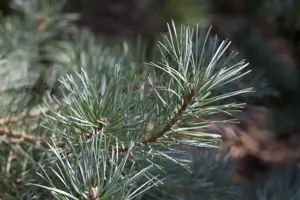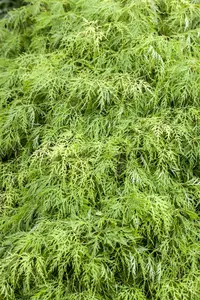Prunus laurocerasus 'Hibani' - 30-40 CM BR
Prunus laurocerasus 'Hibani' - 30-40 CM BR
Description
The Cherry laurel 'Hibani' (Prunus laurocerasus) is a shrub that produces white, clustered flowers with a strong fragrance. They appear from May to June. They produce black, round fruits from August. They exude a strong fragrance. The Cherry laurel 'Hibani' also has shiny, egg-shaped, dark green leaves. The bronze-coloured shoots are also an interesting sight. In a sunny to semi-shady, wind-protected location with well-drained, nutrient-rich soil, it usually reaches a height of approx. 3 metres and grows to a width of approx. 3 metres.
Synonym
Synonyms (botanical): Laurocerasus officinalis.
Bulletpoints
* the flowers are heavily favoured by bees, bumblebees and hoverflies
* strongly scented flowers
* suitable for containers
* bronze budding
Leaves
The evergreen leaves of Cherry laurel 'Hibani' are dark green, ovate, glossy, alternate. Bronze-coloured shoots.
Spread
Southeast Europe.
Frost hardiness
The Cherry laurel 'Hibani' has good frost hardiness.
Growth
Cherry laurel 'Hibani' is a shrub. It usually reaches a height of 2 - 3 m and is approx. 2 - 3 m wide.
Water
The plant has a medium water requirement.
Location
Preferred location in a sunny to semi-shady, wind-protected position.
Soil
Standard container plant soil.
Normal soil.
Planting time
Container plants can be planted all year round, except when the soil is frozen and in summer heat (over 30°C).
Planting partner
The Cherry laurel 'Hibani' sets beautiful accents together with:
Red hedge barberry 'Atropurpurea'.
Tasks
- Mulching: In the period from March to April
- Pruning: In the period from mid-March to early April.
Care
- Frozen shoots are pruned back to healthy wood as soon as there is no longer any danger of frost.
- If watering is less frequent but thorough and penetrating, the plant roots are stimulated to penetrate into deeper soil layers. This enables the plant to survive dry periods better.
Flower
The white flowers of Cherry laurel 'Hibani' appear in clusters from May to June. They are strongly scented.
Interesting facts
Plant or parts of the plant are poisonous.
Use
Tub, privacy screen, hedge (pruning), bee pasture, bird food plant
- Article number3800
-
EAN codePRLHIBAN-2030040Z
- Latin namePrunus laurocerasus 'Hibani'
- catalogLandscape shop



